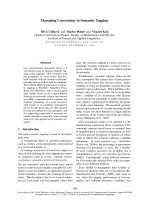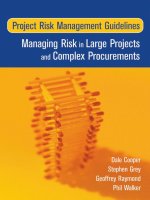Managing+ risk+in+ negotiation
Bạn đang xem bản rút gọn của tài liệu. Xem và tải ngay bản đầy đủ của tài liệu tại đây (4.83 MB, 24 trang )
Choose Your Frame
Stephen Kozicki
Author of The Creative Negotiator
$9.99
Managing Risk in Negotiations: Choose Your Frame
©Bennelong Publishing Pty Ltd, 2017.
All rights reserved. No part of this publication may be reproduced, stored in a
retrieval system, or transmitted in any form or by any means, electronic,
mechanical, photocopying, recording or otherwise without prior permission of the
publisher.
This publication is designed to provide accurate and authoritative information in
regard to the subject matter covered. It is provided with the understanding that the
publisher is not engaged in rendering legal, accounting, or other professional
services. If legal advice or other expert assistance is required, the service of a
competent professional person should be sought.
Published by Bennelong Publishing Pty Ltd
PO Box 500
St Ives NSW 2075
Australia
Editor: Jill Thain
Design and page layout: Jill Thain
Author: Stephen Kozicki
Title: Managing Risk in Negotiations: Choose Your Frame
ISBN: 978-0-9945795-8-4
Subject: Negotiation, Risk Management
Other Authors/Contributors: Gary Peacock
This eBook is distributed internationally through Bennelong Publishing Pty Ltd. The
authors can be contacted at www.bennelongpublishing.com for further information
or inquiries on conferences, keynotes or workshops.
2
Managing Risk in Negotiations: Choose Your Frame
2
3
Contents
Introduction
4
What is your risk-taking style?
6
How should you frame the risk in your negotiation?
8
Choose How You Manage Your Risk
11
How Can You Ensure Compliance
14
Try using contingent agreements
16
When negotiating check your financial risk
20
Summary
21
Questions to Challenge You
22
References
23
Managing Risk in Negotiations: Choose Your Frame
Chapter
Introduction
You need to be on your guard about the level of risk that you
adopt during your negotiations. Every negotiation will involve a
certain amount of risk, but how can you reduce the effect of risk
when you negotiate.
Managing risk in a negotiation is not about trying to eliminate risk but rather
managing the risk to help both parties find an optimal solution. There are four
elements to this:
• Avoid Risk
The Frog and the Scorpion
• Transfer Risk
Wanting to get across a river, a scorpion asks
• Accept Risk
a frog for a ride on its back. The frog is
• Reduce Risk
concerned that that scorpion might sting it,
until the scorpion assures the frog that such
an act would lead to the demise of both.
Halfway across the river with the scorpion on
Understand your preferred personal risk-
its back, the frog feels the scorpion’s
taking style; Proactive or high risk-taker
venomous stinger in its side. As they begin to
or Reactive and low risk-taker. Also,
sink beneath the waves, the frog cries out for
understand that during your negotiation
an explanation, since both will now die.
you will need to engage in both
“I can’t help it”, the scorpion replies, “it’s in
behaviours, ensuring that you don’t take
my nature”.
unnecessary risks or lose opportunities.
Be aware when negotiating that most people are motivated by loss aversion where
avoiding loss is more important than a gain. They judge the outcomes in a
negotiation compared to a reference point.
If you have a negotiation that requires some level of compliance, how can you ensure
the other party fulfils their part of the deal? For compliance you need to ensure you
can identify non-compliance and there are consequences for non-compliance.
Without either of these components it will be difficult to ensure compliance. As with
the story of the frog and the scorpion.
Managing Risk in Negotiations: Choose Your Frame
4
A lot of negotiations fail due to difference of opinion. Rather than keep arguing about
them, turn these differences into value. Create a contingent agreement and bet on
different outcomes. Many negotiators are unaware of these agreements but they can
be both appropriate and beneficial in many business negotiations.
When negotiating your agreement, make sure you have addressed all the financial
risks. Particularly if the agreement will last more than 12 months.
Risk comes from not knowing what you are doing.
Warren Buffett
Managing Risk in Negotiations: Choose Your Frame
5
Chapter
What is your risk-taking
style?
Risk taking in negotiations is unavoidable, but how does your
risk-taking style affect the outcomes.
Goethe said ‘Boldness has genius, power and magic in it.’ It’s good to take
calculated risks but beware emotional risks prompted by the heat of the
negotiation.
There are two main risk styles when negotiating.
Reactive
Proactive
During the negotiation both sides will move along this continuum, tacking back and
forth.
Some people revel in taking risks, and some go through
life taking no risks at all.
Nicholas WInton
Managing Risk in Negotiations: Choose Your Frame
6
Proactive Risk Style
This is a high risk-taking style. Negotiators will be assertive by proposing ideas,
suggestions and different options. They will assert their interests using logical and
emotional arguments.
Reactive Risk Style
This is low risk-taking style. Negotiators will want to maintain their status quo.
They will handle disagreements passively, worrying more about the feelings of the
other side than the substantive issues.
Risk-taking is part of negotiating, especially during the agreement phase. Make
sure you don’t agree to something you’re not happy about.
I talk a lot about taking risks, and then I follow that up
very quickly by saying, ‘Take Prudent Risks’.
Irene Rosenfeld
Find out more about risk taking styles in negotiation in:
The Creative Negotiator
Managing Risk in Negotiations: Choose Your Frame
7
Chapter
How should you frame the
risk in your negotiation?
How you frame your arguments in your negotiation will determine
whether the other person views it as a loss or gain.
An abundance of research supports the idea of loss aversion. Simply, this is that for
most people losses loom larger than gains.
If we could be freed from our aversion to loss, our whole
outlook on risk would change.
Alan Hirsch
An additional gain is more pleasurable than the initial gain and an additional loss is
more painful than the initial loss.
So, how should you use losses and gains to influence in your negotiation. Try these
exercises from Professor Richard Thaler, Nobel Prize winner.
Exercise 1: Which of these two situations
Exercise 2: Which of these two situations
would make you happier?
would make you unhappier?
A – You are walking down the street and
C – You open your wallet and discover you
find a $20 bill.
have lost a $20 bill.
B – You are walking down the street and
D – You open your wallet and discover
find a $10 bill. The next day, walking on a
you have lost a $10 bill. The following day
different street, you find another $10 bill.
you lose another $10 bill.
Exercise 1 – both these scenarios have identical payoffs (a $20 gain). However most
people would be happier in scenario B.
Exercise 2 – both these scenarios have a loss of $20. Yet, most people claim they
would be unhappier in scenario D.
People prefer to receive money in instalments but lose money in one lump sum.
Remember this when framing your gains or losses in your negotiation.
Managing Risk in Negotiations: Choose Your Frame
8
What is loss aversion?
Watch the Veritasium video below to see people experiencing loss aversion.
The Reference Point
The reference point determines how the negotiation outcomes are framed (as either
losses or gains) and how the outcome is valued.
Individuals generally do not evaluate outcomes in absolute terms, but rather as
changes with respect to some reference point. The reference point can be an
aspiration level, the status quo, a prior contract or the deal reached by a virtual
colleague.
Nothing is either good or bad, but thinking made it so.
William Shakespeare
9
Managing Risk in Negotiations: Choose Your Frame
9
Example:
Imagine you bought a house 10 years ago for $400,000. You estimate the market
value now is $800,000, and put the house on the market for $900,000. You receive
an offer for $700,000, how do you view it:
• As a $300,000 gain compared to the original price?
• As a $100,000 loss compared to your target price?
• As a $200,000 loss compared to your ideal price?
If you see it as a gain you are more likely to accept the offer. If you see it as a loss
you are more likely to reject the offer. Any gain or loss is relative to a reference
point.
It’s funny how the beauty of art has so much more to do
with the frame than the artwork itself.
Chuck Palahniuk
10
Managing Risk in Negotiations: Choose Your Frame
10
Chapter
Choose How You Manage
Your Risk
In business, there is a constant tension between managing risk
and capitalising on opportunities.
The world of strategic negotiation is changing fast. To remain a key partner to your
top B2B accounts, you must be relevant and you must help your top accounts
manage risk. This is the essence of negotiating in this brave new world.
How you frame risk with key decision makers in your top accounts will determine
how effective your negotiations are. You may have discovered an opportunity to help
one or more of your strategic accounts to deliver a better business outcome for
them, but this may mean change and at the moment that is risky.
The biggest risk is not taking any risk… In a world that’s changing
really quickly, the only strategy that is guaranteed to fail is not
taking risks.
Mark Zuckerberg
Managing Risk in Negotiations: Choose Your Frame
11
When managing risk in a negotiation your focus is not to try and eliminate risk, but
manage the risk and help your account manage the risk to their business.
There are four elements to the ‘risk management’ model.
Avoid Risk
Avoiding the risk for your key account is often a decision that they need to take
about how they deal with their B2B customers. Help your account see that a
change in a business process can help them avoid risk with their customers in the
next step of the value chain.
Transfer Risk
Transferring the risk of changing your key account’s process by outsourcing a
business process to a third-party supplier can enhance the outcome. For example,
often another group may have a specialty in supply chain management that can
increase customer satisfaction for you. The beauty of this approach is that you can
link any negotiation with the third-party supplier’s success metrics for your top
account.
Accept Risk
Accepting the risk often means staying with the status quo. Perhaps persuading
your account to accept a change might involve too big a change. It if is clear that
outsourcing is not going to work, find ways to help them come up with ideas to
manage current costs more effectively. Your job is to find their problem and then
help them solve it.
Managing Risk in Negotiations: Choose Your Frame
12
Reduce Risk
Reducing the account risk for a new idea or a better way of doing business is a way
you can be most ‘relevant’. Lessons from other key accounts can be applied to this
account. For example, by showing how you have helped another account using
your speed-to-market model to increase their revenues.
For more advice on managing risk in negotiations read chapter 4 of the below ICAC
report.
Managing Risk in Direct Negotiations
Try running some ‘what-if’ scenarios to develop better outcomes. You need to
understand your account’s business at a deeper level if you are to find an
opportunity for your top account. Consider how you frame the risk so that your
accounts see the benefit of making the changes.
You will also need to consider whether the risk for your negotiation is high,
medium or low and then act accordingly.
Some questions to ponder:
• What are the internal risk factors for this negotiation?
• What are the risk factors in the market that could affect this
negotiation?
• What are the three to four key risks in this negotiation and what are
you doing to mitigate them?
• Have you identified whether each risk is high, medium or low?
Living at risk is jumping off the cliff and
building your wings on the way down.
Ray Bradbury
Managing Risk in Negotiations: Choose Your Frame
13
Chapter
How Can You Ensure
Compliance
Some negotiations contain an element of compliance. So, how
can you get the other party to fulfil their part of the deal.
You can determine how likely someone is to comply by using a simple equation.
Compliance = (How likely will get caught) x (Consequences if caught)
Use a number out of 10 for each of these and see what the difference will be.
Example 1:
Example 2:
How likely will get caught = 10
How likely will get caught = 10
Consequences if caught = 1
Consequences if caught = 10
Total = 10
Total = 100
As you can see from the examples above, you need to ensure that you have the
relevant audits in place to catch someone who is not complying. However, if they do
not comply there needs to be consequences. If you are not going to spend the time
and effort policing the compliance then people will not comply. Equally if you catch
them but just shout at them and there are no further consequences then people will
not comply.
To ensure compliance you need to have audits in place and consequences for noncompliance.
If companies know we’re going to
enforce the law,
you’ll see more compliance.
Andrew Cuomo
Managing Risk in Negotiations: Choose Your Frame
14
Negotiating with Liars
Research shows that most people are quite
incompetent as lie detectors. Liars are not easy
to spot. To protect against deception you should
research their background to find out if they are
genuine.
If you are unsure of their motives, ask the other
side to come clean. “Is there something
important that you know about this deal that
you haven’t told me?” To check their
trustworthiness, ask questions that you already
know the answer to. Take notes during your
Lying is a central aspect of
human behaviour.
Negotiators need to learn
about every tool that will
protect their interests.
Robert S. Adler
negotiation.
The reality is that parties are more likely to trust
each other when they have a means of
determining whether the other party’s
representations are accurate.
Use contingent agreements for protection
Insist on a ‘contingency’ provision in the contract that provides specific protection
should the representation turn out to be false. In contingency agreements, the
parties agree in advance on consequences and remedies (including monetary
damages) if and when certain events unfold.
Check out the article below by Robert Adler:
Negotiating With Liars
Managing Risk in Negotiations: Choose Your Frame
15
Chapter
Try using Contingent
Agreements
Many negotiations fail because of differences of opinion on what
the future looks like. It is often better to bet on uncertainty rather
than to argue about it.
Many negotiators are unaware of these agreements, or see them as a form of
gambling – which is just not done in business. But these agreements can be both
appropriate and beneficial in many kinds of business negotiations.
Technology negotiations are particularly complex and risky, using contingent
agreements is a good way to mitigate this risk.
Why Technology Negotiations Are Different
What are the benefits of contingent agreements?
Turning Differences into Value
Differences provide the basis for tradeoffs that can pave the way to mutually
beneficial agreements. Making differences the basis for a bet with benefits for both
parties, negotiators can avoid long, costly arguments – focusing on mutual
interests not speculative disagreements.
A large conglomerate hired a consultancy firm to turn
around a struggling division. The consultancy firm was
convinced they could solve the problems and created a
plan. At this time, the conglomerate received a $100
million offer for the division.
The consultancy firm argued that if they followed the
plan the division would be worth $200 million in two
years. The conglomerate believed this was a rosy
projection and was skeptical. They accepted the offer.
If the consultancy firm had offered a contingent
agreement with no fees for their work if the
conglomerate agreed to pay 25% of any amount over
$100 million when the division was sold two years later
– it would have been a win for both parties.
Managing Risk in Negotiations: Choose Your Frame
16
Bypassing Biases
Negotiators are subject to various biases that can distort their positions and
decisions. Contingent agreements offer a different approach, enabling each side to
bet on its bias. The agreements remove the bias as a source of contention by
indulging them. Establishing two future scenarios based on these biases, each side
assumes their scenario will play out and has a strong incentive to accept the
agreement. Allowing negotiators to be flexible without feeling compromised.
Leveling the Playing Field.
Many negotiations are characterised by asymmetric information, with one side
having more information than the other. Contingent agreements are a simple way
to level the playing field.
Big Co. wants to buy Little Co., a small family-owned business. There are a range of
possible values for Little Co. but the true worth is unknown before purchase.
Rather than risk an overgenerous bid, that never generates real returns, Big Co.
offers a baseline amount at the lower end of projections with a sliding scale of
additional payments based on the company’s post-purchase performance.
This will allow the purchase to move forward but delays the final terms until Big
Co. has a chance to inspect the books from an insider perspective. When the
available information is symmetrical.
17
Managing Risk in Negotiations: Choose Your Frame
17
Diagnosing Deceit
The fear of deceit can be a major impediment to all sorts of business agreements.
Contingent agreements are a powerful means of uncovering deceit and neutralising
its consequences. If you face another negotiator who is making a claim that is
possibly deceptive, then contingent agreements can help.
For example, instead of agreeing to pay 100% immediately, make a large proportion
contingent on the potentially deceptive claim. Offer to pay 60% immediately and
60% after the potentially deceptive claim is proved and verified by an independent
third party. This offers the other negotiator more money, however, if they are trying
to deceive you they will refuse the offer of extra money.
Contingent agreements allow a negotiator to test the other side’s truthfulness in a
non-confrontational manner, allowing relationships to remain undamaged.
Reducing Risk
Contingent agreements involve betting which is always risky. Right? Not always,
sometimes it reduces the risk by sharing it among both parties. Shared risk also
creates a lot of goodwill.
The agreement provides a safety net, limiting each sides losses, but it also prevents
one company earning a windfall at the others expense. This trust builds
relationships and sets the stage for mutually beneficial negotiations in the future.
18
Managing Risk in Negotiations: Choose Your Frame
18
Motivating Performance
Contingent agreements motivate parties to perform at or above contractually
specified levels.
A public relations firm made a compelling sales pitch to a software company,
claiming it could double the company’s sales. The software company was impressed,
but had heard rumours that the PR company often presented its star players at point
of sale, then turned the project over to less talented underlings.
A contingent agreement based the software company’s fee on actual changes in sales,
making it in the best interests of the PR firm to use its best talent on the account. By
rewarding outstanding results, it motivated outstanding performance.
Contingent agreements are not right in every situation, keep in mind:
• They require continuing interaction between parties. The final outcome is not
determined until sometime after initial agreement. Consider the nature of your
future relationship with the other party.
• Consider the enforceability of the agreement. Don’t bet on it if you can’t collect.
• Agreements require transparency. You must be able to observe and measure the
future event you are betting on. Also, ensure that neither side can manipulate
the outcome. The terms should be clearly defined in the agreement.
In an increasingly uncertain world, flexible contingent agreements can be more
rational and less risky than rigid, traditional ones.
Max Bazerman and James Gillespie share their views in the article, Betting on the
Future: The Virtues of Contingent Contracts.
Read the full article below:
Betting on the Future: The Virtues of Contingent Contracts
If you are not willing to risk the unusual,
you will have to settle for the ordinary.
Jim Rohn
19
Managing Risk in Negotiations: Choose Your Frame
19
Chapter
When Negotiating Check
Your Financial Risk
When negotiating remember to consider your financial risks.
Exchange Rate Risk
How will a change in exchange rates affect your sales?
How will a change in exchange rates affect your costs?
Interest Rate Risk
How will a change in interest rates affect your costs?
Commodity Price Risk
How will a change in price affect your costs, e.g. oil, metals?
Please pay special attention to these risks when agreements last more than 12
months.
Managing Risk in Negotiations: Choose Your Frame
20
Chapter
Summary
You will never eliminate risk from negotiations.
You will never eliminate risk from negotiations, so you need to prepare for different
possible scenarios.
Your need to be a successful negotiator is normal, and is intrinsically linked to your
ability to take risks.
Only those who risk going too far
can know can possibly find out how far they can go.
T.S.Elliott
Managing Risk in Negotiations: Choose Your Frame
21
Necessity is the mother of
taking risks.
Mark Twain
Chapter
Questions to
Challenge You
1. How do you manage risk in your negotiations and still capitalise on opportunities?
2. How do you establish which business processes will be affected by your
negotiation?
3. How do you identify the risk factors in the market that could affect your
negotiation?
4. How do you decide what the level of risk is in your negotiation (high, medium, low)?
How do you mitigate these risks?
5. How do you use your risk-taking style to your advantage during your negotiation?
6. How do you frame the risk in your negotiations?
7. How to do you determine the reference point the other party will refer to in your
negotiation?
8. How do you ensure compliance?
9. When do you consider using a contingent agreement as part of your negotiation
contract?
Managing Risk in Negotiations: Choose Your Frame
22
Chapter
References
Bazerman, M.H. & Gillespie, J.J. (1999), Betting on the Future: The Virtues of Contingent
Contracts, Harvard Business Review.
Deepak, M. & Bazerman, M.H. (2008), Psychological Influence in Negotiation: An Introduction
Long Overdue, Journal of Management, 34(3): 509-531.
Druckman, D. (2000) Bridging the gap between negotiating experience and analysis, In M.
Wheeler (Ed), Focus on negotiation pedagogy teaching negotiation: Ideas and innovations,
231, Cambridge; PON.
Goleman, D. (2013) Focus: The Hidden Driver of Excellence, Bloomsbury.
Kahneman, D. (2011) Thinking, fast and slow, Penguin Books.
Kozicki, S. (2016)(, The Creative Negotiator, 2nd Ed, Bennelong Publishing.
McGinn, K.L. & Noth, M. (2012) Communicating Frames in Negotiations, Harvard Business
School, 12-109, June 13, 2012.
Mnooki, R.H. & Peppet, S.R. & Tulumello, A.S. (1996) The Tension Between Empathy and
Assertiveness, Negotiation Journal, July 1996.
Putnam, L.L. (1990) Reframing Integrative and Distributive Bargaining: A Process Perspective,
JAI Press Inc, In Research on Negotiation In Organisations, 2:3-30.
Shapiro, .L. (2006) Teaching students how to emotions as they negotiate, Negotiation Journal,
105-109.
Susskind, L. (2005), Don’t Like Surprises? Hedge Your Bets with Contingent Agreements,
Harvard Business School.
Susskind, L. (2006), Why Technology Negotiations Are Different, Contract Management.
Thaler, R. (1985), Mental Accounting and Consumer Choice, Marketing Science, Vol 4, No. 3,
pp.199-214.
(Veritasium)
Vitasek, K. & Manrodt, K. (2012) Vested: How P&G, McDonalds And Microsoft Are Redefining
Winning In Business Relationships, Palgrave MacMillan.
Watkins, M. (2000) Negotiation Analysis: A Synthesis, Harvard Business School, 9-800-316,
May 8, 2000.
Managing Risk in Negotiations: Choose Your Frame
23
The Problem
Negotiations in the B2B world are becoming
more and more complex. With each level of
complexity there is increased risk.
How can you manage this increased risk and
still chase opportunities to increase your
business results, increase your market share
and build barriers to competition?
The Future
In negotiations you will need to help the other
party manage the risk to changes in their
business. How you frame the risk will
determine how the other party views the risk
and what they will reference it against, either
as a loss or as a gain.
Where there are insurmountable differences of
opinion on the outcomes of a negotiation,
consider using a contingent agreement to find
resolution. Make sure that you have processes
in place to manage compliance to your
agreement.
www.gordianbusiness.com.au
gordian-business
@GordianBusiness
Managing Risk in Negotiations: Choose Your Frame
24









